Ha llegado el momento, en mis estudios de pastelería, de probar la gastronomía dulce de China. Cuando la chef instructora, indico que haríamos algunas preparaciones de China, yo quise adelantarme y practicar las recetas antes y es algo que suelo hacer siempre con tiempo, para luego en clases corregir cualquier error y seguir aprendiendo. Nunca había trabajado con harina de arroz glutinosa y es algo que tenía pendiente porque quiero preparar mochis. Para evitar cualquier sorpresa durante la clase, decidí practicar antes una de las preparaciones y me han encantado el resultado y hoy quiero compartir la receta con ustedes.
The time has come, in my pastry studies, to try the sweet gastronomy of China. When the chef instructor indicated that we would make some preparations from China, I wanted to go ahead and practice the recipes before and it is something I always do ahead of time, so that later in class I can correct any mistakes and continue learning. I had never worked with glutinous rice flour and it is something I had pending because I want to prepare mochis. To avoid any surprises during the class, I decided to practice before one of the preparations and I have loved the result and today I want to share the recipe with you.

Las bolas de sésamo, es una preparación que va constituida con un relleno de una pasta anko, es una pasta que se hace a base de frijoles rojos y se le coloca azúcar. Esta pasta se cubre con una masa que se hace con la harina de arroz glutinoso y luego se empaniza con semillas de sésamo. El resultado es un postre que es crocante por fuera, con un sabor fuerte a sésamo, seguido a esta capa viene una capa suave y elástica y un relleno suave y con mucha textura. Todo junto tiene un sabor que a mí me gusta y que es diferente a lo que particularmente estoy acostumbrado.
Sesame balls are a preparation made with an anko paste filling, a paste made with red beans and sugar. This paste is covered with a dough made with glutinous rice flour and then breaded with sesame seeds. The result is a dessert that is crunchy on the outside, with a strong sesame flavor, followed by a soft and elastic layer and a soft and textured filling. All together it has a flavor that I like and that is different from what I am particularly used to.
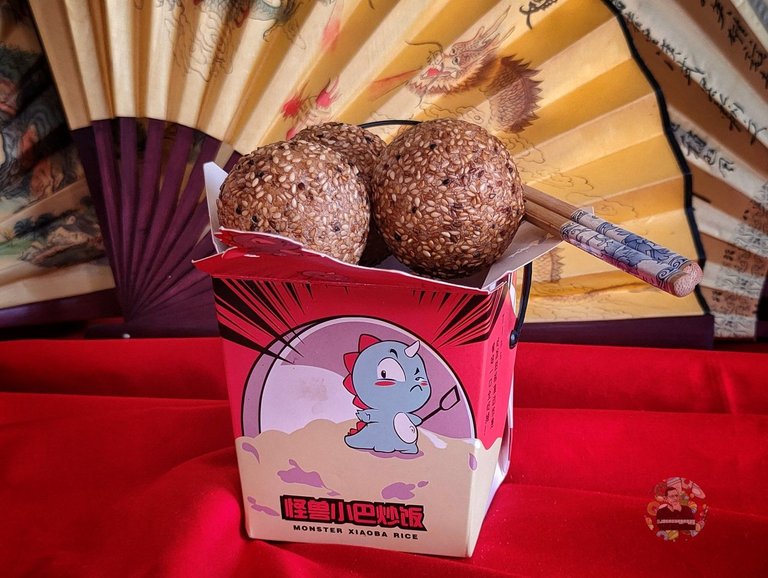
A pesar de que visualmente puede parecer algo muy sencillo, todo se centra al momento de cocinarlos. Como es una preparación frita, se debe hacer siguiendo ciertas indicaciones, para evitar que se queme las semillas de sésamo, se cocine demasiado rápido y no se infle como debe ser. Cuidar los detalles, durante el proceso de cocción, hará que se obtenga unas bolas de sésamo "perfectas" y que la experiencia al comerlas, sea la mejor.
Although visually it may seem very simple, everything is centered at the moment of cooking. As it is a fried preparation, it must be done following certain indications, to avoid burning the sesame seeds, cooking too fast and not puffing up as it should be. Taking care of the details, during the cooking process, will result in "perfect" sesame balls and the best eating experience.
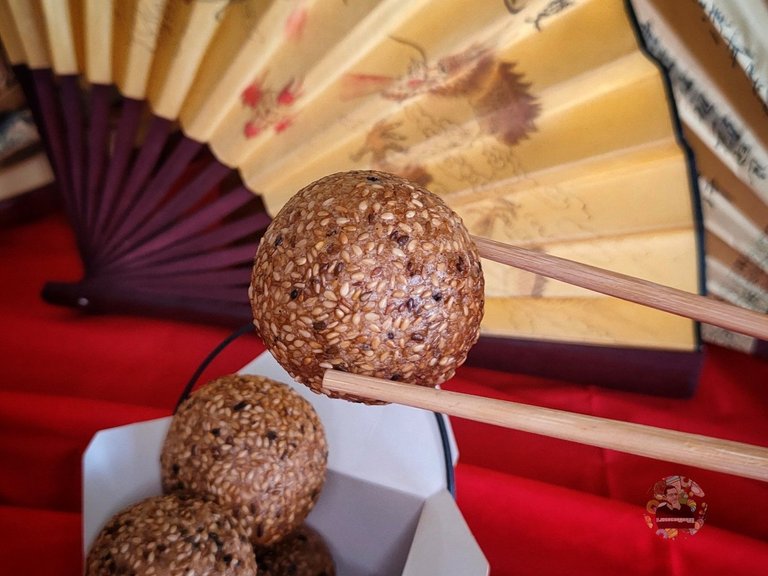
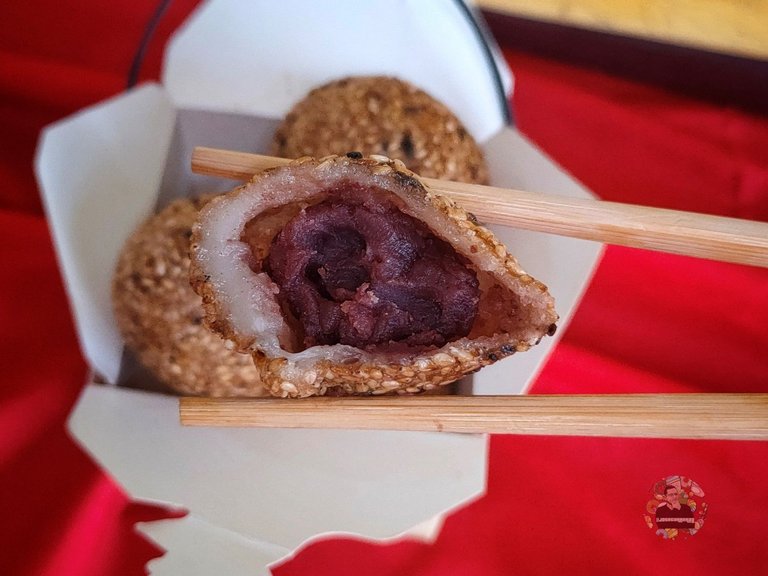
Si quieres aprender a preparar las bolas de sésamo, estos son los ingredientes que yo utilice:
If you want to learn how to prepare sesame balls, these are the ingredients I used:

Ingredientes || Ingredients
|
|

Preparación || Preparation
- Lo primero es tener la harina de arroz glutinoso, no se puede utilizar cualquier otra harina de arroz, hay que asegurarse que sea la que diga glutinoso.
- The first thing is to have glutinous rice flour, you cannot use any other rice flour, you must make sure it is the one that says glutinous.

- Se divide el agua a la mitad y a una de las partes, se agrega la azúcar y se disuelve la azúcar por completo. La otra mitad de agua, se reserva.
- The water is divided in half and to one of the parts, the sugar is added and the sugar is dissolved completely. The other half of the water is reserved.

- Se coloca la harina en un bol y haciendo un hueco en el centro de la harina, se agrega el agua con azúcar. Se comienza a unir la harina con el agua, hasta obtener una masa suave y manejable. El resto de agua, es para ir agregando a medida que sea necesario. La masa no puede quedar dura y seca, porque si no será imposible poder trabajarla. La textura de la masa debe ser suave como la de la plastilina. Una vez lista la masa, se deja reposar unos 5 minutos.
- Place the flour in a bowl and making a hole in the center of the flour, add the water with sugar. Begin to mix the flour with the water until a soft and manageable dough is obtained. The rest of the water is to be added as needed. The dough should not be hard and dry, otherwise it will be impossible to work it. The texture of the dough should be soft like that of plasticine. Once the dough is ready, let it rest for about 5 minutes.
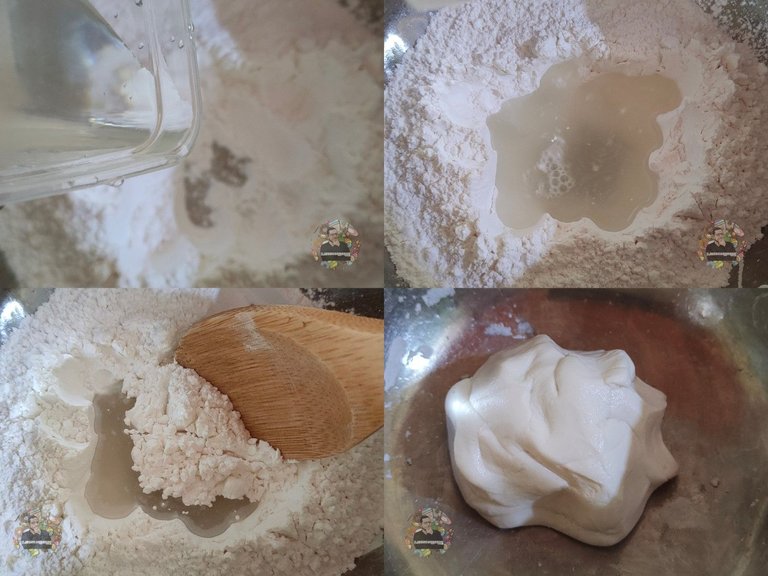
- Se forman bolitas con la pasta anko. Si estas utilizando las cantidades exactas que comparto, rinde para realizar 8 porciones de buen tamaño. Entonces con los 100 gramos de la pasta anko, debes hacer 8 bolitas que pesen lo mismo. La pasta anko luego comparto como se prepara, en caso de que no consigas comprarla, pero es un producto muy típico de ver en las tiendas especializadas de cosas chinas.
The anko dough is formed into small balls. If you are using the exact quantities that I share, it yields to make 8 good sized portions. So with the 100 grams of anko paste, you should make 8 balls that weigh the same. I will share later how to prepare the anko paste, in case you can't buy it, but it is a very typical product to see in specialized Chinese stores.
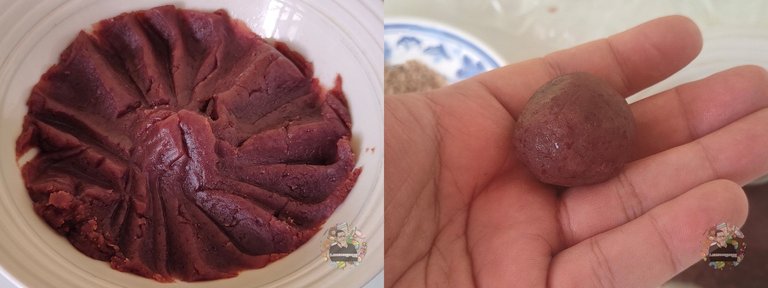
- La masa de harina de arroz glutinoso se divide en la misma cantidad de porciones que se hayan sacado de la pasta anko. Se toma una porción de la masa de arroz, se forma un bolita y luego se aplasta. Se coloca en el centro la bola de pasta anko y se cubre con la otra masa, hasta que quede bien cubierta y se termina de dar forma redonda. Si la masa se te pega en las manos, puedes untarte un poco de aceite.
The glutinous rice flour dough is divided into the same number of portions as the anko paste. Take a portion of the rice dough, form it into a ball and then flatten it. Place the anko dough ball in the center and cover it with the other dough until it is well covered and finish giving it a round shape. If the dough sticks to your hands, you can rub a little oil on them.
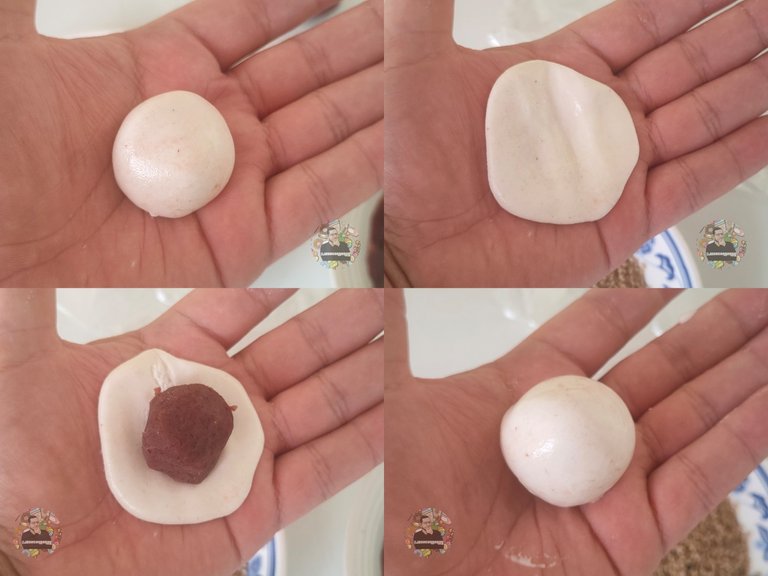
- Se pasa la bola por las semillas de sésamo, se aprieta ligeramente con las manos, para asegurarse de que las semillas queden bien pegadas y se lleva a freír.
- Roll the ball in the sesame seeds, press it lightly with your hands to make sure that the seeds are well stuck and fry it.
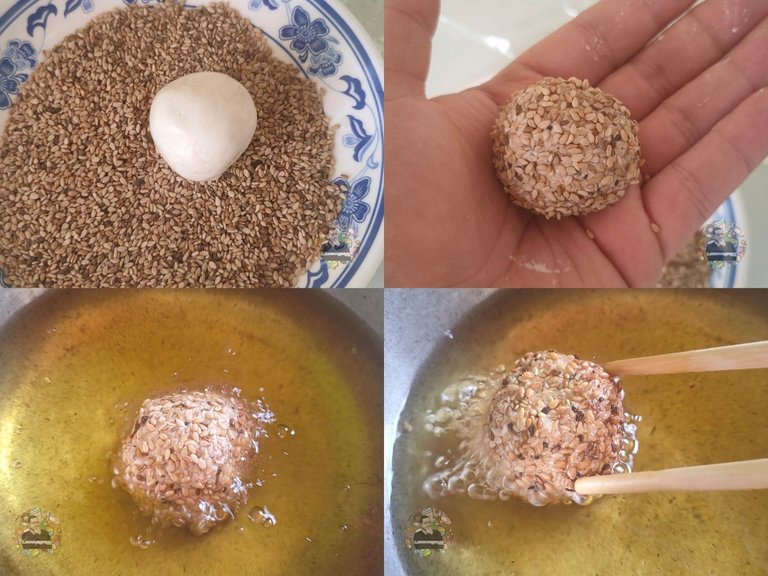
- El aceite no debe estar tan calienta, al inicio la temperatura debe ser de unos 130-150°C. Se deben cocinar por unos minutos, dándoles vueltas a cada bola con mucho cuidado, para que las semillas no se desprendan. Una vez que comience a tener ese ligero color dorado y sin dejar de darles vueltas, se sube la intensidad del fuego un poco, para que la temperatura suba a unos 180°C y de esa forma se comiencen a abombar y se terminen de dorar. Si la temperatura es mayor, el sésamo se quema muy rápido y no crecen las bolas. Una vez listas, se dejan enfriar un poco y como toda fritura, es recomendable comerlas calientes.
- The oil should not be too hot, at the beginning the temperature should be about 130-150°C. They should be cooked for a few minutes, turning each ball carefully, so that the seeds do not come off. Once they begin to have that light golden color and without stopping turning them, increase the intensity of the fire a little, so that the temperature rises to about 180°C and in this way they begin to bulge and finish browning. If the temperature is higher, the sesame burns very fast and the balls do not grow. Once ready, let them cool a little and like all frying, it is advisable to eat them hot.

Ya con esto, las bolas de sésamo o Jian Dui, están listas. Es una preparación muy diferente, y digo diferente porque a la gastronomía que estoy acostumbrado, no se incluyen estos sabores y texturas, pero me ha encantado probar esto y me ha abierto un abanico de posibilidad para crear nuevas preparaciones y fusionar culturas gastronómicas.
With this, the sesame balls or Jian Dui, are ready. It is a very different preparation, and I say different because the gastronomy I am used to does not include these flavors and textures, but I have loved trying this and it has opened a range of possibilities to create new preparations and merge gastronomic cultures.
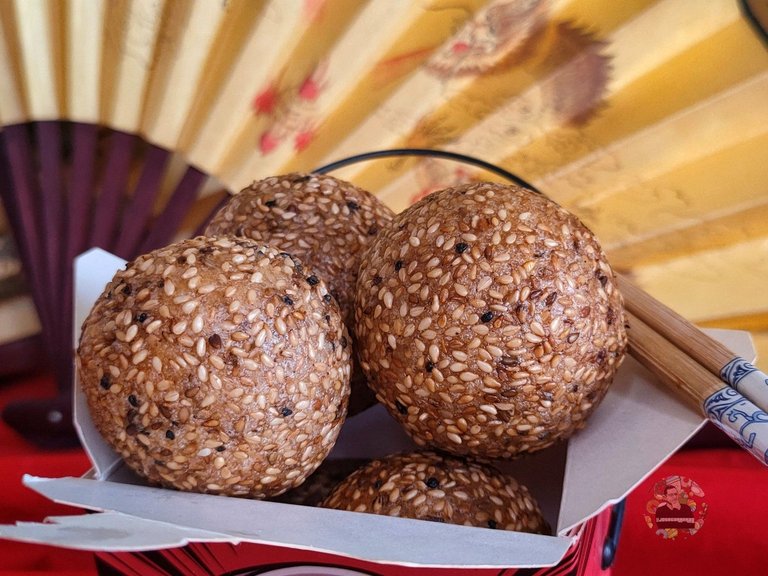
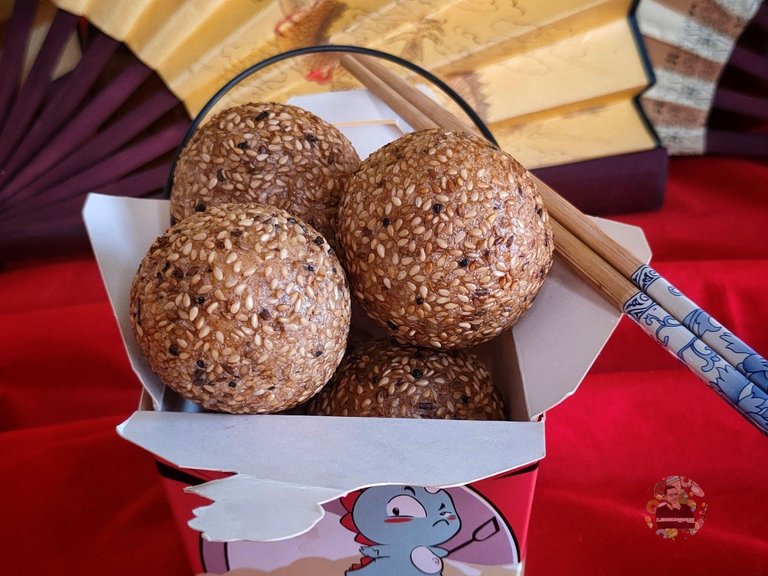
Si tienes acceso a una tienda que vendan cosas típicas de la gastronomía de China o asiática en general, te recomiendo que consigas los ingredientes y te atrevas a probar esta preparación, a veces salir de lo cotidiano hace que podamos apreciar más lo que ya tenemos y podas abrir la mente hacia nuevos sabores, aromas y texturas. ¡Hasta una próxima receta!
If you have access to a store that sells typical Chinese or Asian cuisine in general, I recommend that you get the ingredients and dare to try this preparation, sometimes going out of the ordinary makes us appreciate more what we already have and you can open your mind to new flavors, aromas and textures. Until a next recipe!

Todas las fotografías fueron tomadas por mí con un Realme 7 pro. No autorizo a nadie reutilizarlas. Esta publicación fue escrita en español y luego traducida al ingles.
All photographs were taken by me with a Realme 7 pro. I do not authorize anyone to reuse them. This publication was written in Spanish and then translated into English.
Y de China pa’ Japón. Recuerda que tenemos un viaje pendiente. Falta poco.
Epa, eso tiene buena pinta, se ve buenazo.
Hay que ir preparando el estómago para ese viaje. Como se sobró harina de arroz glutinoso, voy a intentar hacer los mochis de Japón. Japón, pronto vamos 🛩️
Siempre me preguntaba si los chinos comían dulces, porque en sus restaurantes (al menos la mayoría en los que he comido) no suelen ofrecerlos, pero claro luego averigüé y sí existen jajaja.
No había visto ni escuchado sobre estos que preparaste, se ven muy ricos, a mí me encanta el ajonjolí 😃
Ellos comen dulces, pero no como en otras partes del mundo, incluso hay regiones en donde a los niños no se les pueden dar nada de azúcar o cosas muy saladas. Ojalá las puedas probar, no es que sean el mejor postre, pero si es algo que se debe comer para conocer jeje
Sí, he leído que no consumen tanto azúcar como en occidente. Oye, espero que sigas mostrando más dulces asiáticos y de todo tipo jaja :)
Pero a qué sabeeeeee, no me lo imagino jajajaja.
Yo el único postre chino que conozco son las moon cake y tienen un sabor muy curioso, sobre todo si te toca con sorpresa jajaja.
Pero estos tuyos se ven mucho más provocativos, de verdad que nunca,nunca los había visto.
Nina, para tratar de hacerte una comparación, seria como comer buñuelos de yuca empanizados con ajonjolí. Me atrevo a decir que saben igual a los buñuelos y es la misma textura en el relleno. Pero lo que más resalta es un sabor intenso a ajonjolí tostado, como se fríe a baja temperatura al inicio, eso hace que quede bien tostado y crocante.
Los pasteles de Luna tienen también relleno de pasta anko, pero la ponen más seca o le agregan una yema u otras cosas.
Me encantaría probarlos por curiosidad y por lo deliciosas que se ven, todo un éxito amigo que Dios te siga dando sabiduría en todo tiempo. Gracias por compartir tu excelente receta gastronómica veinte punto 👏👏🙏🤗
Gracias, es una preparación que hay que probar, si te gusta el ajonjolí, vas a disfrutarla. Te mando un abrazo 💙
Los buñuelos chinos jeje, se ven sabrosos y muy bonita presentación visual con estas semillas de sésamo que le dan un toque visual dejando en duda a que sabrá.
Para ser primera vez realizando este tipo de dulces te quedó maravilloso😋.
¡Saludos!
mejor dicho, imposible. Son tal cual los buñuelos chinos jajaja. No tenia muchas expectativas, pero quedaron bastante bien.
Wow que deluciosa receta me fascinó amigo @josecarrerag. Me gustaría saber las opciones para preparar la masa de adentro. Desconozco aquí en mi ciudad a donde poder encontrar esa masa. Pero estoy segura que me darás otras alternativas. Gracias amigo por compartir tus conocimientos y aprendizaje. Un placer leerte.
El relleno es una pasta que se hace con frijoles rojos o caraotas rojas y azúcar. Ese es el relleno más tradicional, pero se pueden realizar mas modernos y colocar un relleno de chocolate y quedarían estupendos.
Excellent recipe. Hope it was very tasty to eat. You have described the recipe making process very nicely. I like it. Thanks for sharing the recipe.
Thank you, I liked the taste and texture, it is a dessert that honestly surprised me and I did not have many expectations.